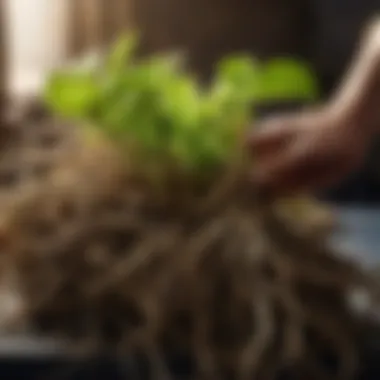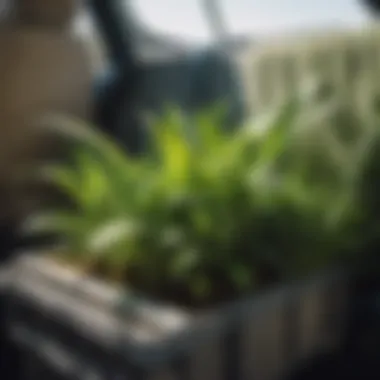Materials:
-
Large cardboard boxes: 3 boxes measuring 18"x24" for transporting plants securely.
-
Packing paper: Approximately 5 large sheets to wrap delicate leaves and prevent damage.
-
Bubble wrap: 1 roll for cushioning fragile pots during transit.
-
Corrugated plant sleeves: 10 sleeves to protect plant stems from breakage.
DIY Steps:
-
Begin by selecting a designated area to assemble your packing materials.
-
Place a layer of packing paper at the bottom of each cardboard box to provide a cushioning base.
-
Carefully wrap each plant in bubble wrap, ensuring all leaves and stems are well-protected.
-
Insert plants into individual plant sleeves to prevent any bending or snapping of stems.
-
Label each box with the name of the enclosed plants for easy identification upon unpacking.
Technical Aspects:
-
Tools: Scissors for cutting packing materials, marker for labeling boxes.
-
Timing: Allocate approximately 2 hours for packing plants, depending on the quantity.
-
Critical Techniques: Ensure all plants are well-secured within their sleeves to avoid movement and damage during transportation.
DIY Project Process:


-
Start by assessing the fragility of each plant and selecting the appropriate packing method.
-
Apply the wrapping and sleeving techniques as detailed in the DIY steps, with careful attention to each plant's unique structure.
-
Prioritize packing heavier, larger plants at the bottom of the box and lighter, smaller plants on top.
-
Seal each box securely with tape and store in a cool, dry place until ready for transport.
-
In case of any shifting or movement during transit, gently reposition plants and add extra padding if needed.
Troubleshooting Tips:


-
If plants appear droopy upon unpacking, give them a generous water and sunlight to help them rejuvenate.
-
In case of any broken leaves or stems, carefully trim damaged parts and monitor plant health closely in the following weeks.
-
Should any plants show signs of distress post-relocation, research specific care tips for each species to address their needs effectively.
Preparation Before Moving


As you embark on the journey of moving with your beloved plants, the preparation before moving serves as a crucial foundation for a successful transition. This initial phase lays the groundwork for ensuring the safety and well-being of your green companions throughout the relocation process. Assessing your plants, researching regulations, and gathering the necessary supplies are key elements to focus on during this preparatory stage.
Assessing Your Plants
Identify Plant Species
Identifying the specific species of plants you own is a fundamental step in preparing for a smooth move. Each plant species has unique care requirements, resilience to environmental changes, and transportation needs. Understanding the distinct characteristics of your plants will enable you to tailor your relocation plans to meet their individual needs effectively.
Evaluate Plant Health
Evaluating the health of your plants before the move is essential to address any existing issues and promote their overall well-being. Healthy plants have a higher chance of surviving the stresses of relocation and adapting to a new environment successfully. By assessing the health of your plants, you can implement appropriate care measures and treatments to ensure they are in the best possible condition before transporting them.
Determine Transportation Needs
Determining the transportation needs of your plants involves considering factors such as size, fragility, and sensitivity to climate variations. Some plants may require specialized containers, padding, and secure fastening during transit to prevent damage. Understanding the specific transportation requirements of each plant will enable you to make suitable arrangements for their safe journey to the new location.
Researching Regulations
Check Local Laws
Checking local laws and regulations regarding the transportation of plants is vital to avoid any legal issues during your move. Different regions have varying restrictions on importing certain plant species to prevent the spread of pests or diseases. Complying with local laws ensures a smooth and lawful relocation process for your plants.
Understand Quarantine Requirements
Understanding quarantine requirements is essential when moving plants across state or international borders. Some areas might impose quarantine periods to inspect plants for potential risks to local ecosystems. Familiarizing yourself with these regulations helps you prepare in advance and prevent any unnecessary delays or complications during the move.
Obtain Necessary Permits
Obtaining the required permits for transporting plants is a crucial aspect of complying with legal guidelines. Certain plants may be protected species, requiring specific permissions for their relocation. Securing the necessary permits well ahead of your moving date ensures a hassle-free process and eliminates last-minute challenges.
Gathering Supplies
Plant Containers
Selecting appropriate plant containers is essential for safeguarding your plants during the relocation journey. Sturdy, well-ventilated containers that provide ample space for roots and foliage prevent damage and promote air circulation. Choosing the right containers tailored to each plant's size and resilience enhances their safety and comfort during transportation.
Packing Materials
Utilizing high-quality packing materials such as cushioning agents, shredded paper, or foam inserts is crucial for securing plants in their containers. Packing materials offer added protection against shifting and impact during transit, reducing the risk of breakage or stress-induced damage. Properly wrapping and securing plants with suitable materials help maintain their stability throughout the moving process.
Protective Gear
Equipping yourself with appropriate protective gear like gloves, masks, and eye protection ensures your safety and prevents any allergic reactions while handling plants. Some plants may have thorns, spines, or toxic components that can cause skin irritation or other health hazards. Wearing protective gear minimizes risks and allows you to handle plants with confidence and care.
Packing and Transporting Plants
When it comes to moving with plants, the process of packing and transporting them is crucial for their safety and well-being. Properly securing your plants during transit ensures that they arrive at their new location in optimal condition. The careful handling of plants at this stage sets the foundation for a successful relocation.
Securing Plants for Transit
Prune and Trim Plants
Pruning and trimming your plants before moving plays a vital role in reducing bulk, promoting new growth, and minimizing the risk of damage during transportation. By trimming overgrown foliage and pruning excessive branches, you not only make the plants more manageable to pack but also rejuvenate them for their new environment. This step enhances the overall health and appearance of the plants.
Use Appropriate Containers
Selecting the right containers for your plants is essential to prevent shifting, breakage, and moisture loss during transportation. Opt for containers that provide adequate space for the plant's roots while offering support to prevent any damage. Choosing breathable containers also ensures proper air circulation for the plants, aiding in their survival during the move.
Secure Pots During Transit
Securing pots effectively during transit involves using cushioning materials such as packing peanuts or shredded paper to stabilize the pots and minimize movement. Additionally, securing the pots with straps or tie-downs in your vehicle or ensuring they are placed securely within moving boxes prevents them from toppling over and causing harm to the plants. Properly secured pots are essential for maintaining the plant's stability throughout the journey.
Choosing the Right Transportation Method
Personal Vehicle
Transporting plants in your personal vehicle offers the advantage of maintaining control over the transportation conditions. It allows you to monitor the plants closely, regulate temperature settings, and ensure a smooth ride for your green companions. The personal touch and the ability to make stops as needed make this method a popular choice for plant owners.
Professional Movers
Opting for professional movers for transporting your plants provides expert handling and specialized equipment to ensure the plants' safe arrival. Professional movers have experience in fragile item transportation and can offer tailored solutions for delicate plants, reducing the stress associated with moving them yourself. Consider this method for a hassle-free plant relocation experience.
Shipping Services
Using shipping services to transport your plants is ideal for long-distance moves or international relocations. These services offer temperature-controlled environments, careful handling of packages, and tracking options to monitor the plants' journey. While this method may involve longer transit times, it is a convenient option for moving plants across significant distances.
Ensuring Plant Safety
Protect Plants from Extreme Temperatures
Shielding plants from extreme temperatures during transit is vital to prevent heat stress or cold damage. Employ insulation materials such as bubble wrap or blankets to regulate the temperature around the plants. Avoid exposing them to direct sunlight or freezing conditions, ensuring they remain comfortable and healthy throughout the move.
Provide Adequate Ventilation
Ensuring sufficient airflow around the plants while in transit prevents moisture buildup and maintains proper oxygen levels. Proper ventilation reduces the risk of mold, mildew, or suffocation due to restricted air circulation. Ventilation holes in containers or breathable packaging materials promote plant respiration, enhancing their resilience during transportation.
Monitor Plants During Transit
Continuous monitoring of plants during the relocation process allows you to address any issues promptly and provide necessary care. Regularly check the plants for signs of distress, wilting, or damage, adjusting ventilation or moisture levels as required. Monitoring plant health ensures their well-being and enables timely interventions to preserve their vitality throughout the journey.
Settling In at the New Location
When it comes to moving with plants, perhaps the most crucial phase of the process is settling in at the new location. This step is vital for ensuring that your plants adapt successfully to their new environment and thrive in their new home. By acclimating your plants properly, you are setting the foundation for their well-being and longevity.
Additionally, acclimating your plants to the new environment helps minimize the shock they may experience from the move, promoting a smoother transition and reducing the risk of stress-related issues. It allows your plants to gradually adjust to the new levels of sunlight, humidity, and temperature, ensuring their overall health and growth.
Settling in at the new location involves a careful balance of patience and attention to detail. By gradually exposing your plants to sunlight, adjusting their watering schedule, and monitoring their health, you can create a nurturing environment that supports their acclimation process. Remember, the goal is to create a seamless transition that prioritizes the well-being of your green companions.
Acclimating Plants to the Environment
Gradual exposure to sunlight
One key aspect of acclimating plants to a new environment is through gradual exposure to sunlight. This gradual approach helps prevent sunburn and leaf damage, which can occur if plants are suddenly exposed to intense sunlight after being indoors or in a shaded area for an extended period. Gradual exposure allows plants to adjust their photosynthesis process gradually, enhancing their ability to produce energy efficiently. This method is particularly beneficial for delicate or sensitive plant species. However, it is essential to monitor the plants closely during this process to ensure they are responding positively to the increased sunlight levels.
Adjusting watering schedule
Adjusting the watering schedule is another critical component of acclimating plants to a new environment. Changes in humidity levels, temperature, and sunlight exposure can impact the plant's water requirements. By adjusting the watering schedule gradually, you can help prevent overwatering or underwatering, both of which can lead to significant stress for the plants. It is essential to observe the plants closely for signs of moisture stress or excess water, adjusting the watering frequency accordingly. This tailored approach ensures that your plants receive the right amount of water to support their growth and development.
Monitoring plant health
Monitoring the health of your plants throughout the acclimation process is paramount. Keep a close eye on leaves, stems, and overall plant appearance for any signs of stress, disease, or pest infestation. Regularly inspecting your plants allows you to address any issues promptly, preventing potential problems from escalating. By monitoring plant health, you can provide timely care and attention, ensuring that your plants remain strong and resilient during the acclimation period. Remember, a proactive approach to monitoring plant health is key to successful acclimation and long-term plant care.





